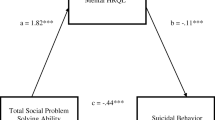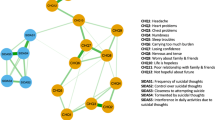Abstract
Individuals with problem solving deficits, and higher levels of neuroticism and hopelessness, are at increased risk for suicide, yet little is known about the interrelationships between these vulnerability characteristics. In a sample of 223 low-income, primary care patients, we examined the potential mediating role of hopelessness on the relation between neuroticism and suicidal behavior, and the potential moderating role of social problem solving ability. Participants completed self-report questionnaires: Suicidal Behaviors Questionnaire-Revised, Social Problem Solving Inventory-Revised, Beck Hopelessness Scale, and NEO Five Factor Inventory. Models were tested using bootstrapped moderated mediation techniques. There was a significant indirect effect of neuroticism on suicidal behavior through hopelessness, and this indirect effect was moderated by social problem solving ability. Patients with greater neuroticism also manifest greater levels of hopelessness and, in turn, more suicidal behavior, and these relations are strengthened at lower levels of social problem solving. Interventions that increase social problem solving ability and reduce hopelessness may reduce suicide risk.

Similar content being viewed by others
References
American Association of Suicidology. (2012). National Suicide Statistics. http://www.suicidology.org/stats-and-tools/suicide-statistics. Retrieved August, 2, 2012.
Amstadter, A. (2008). Emotion regulation and anxiety disorders. Journal of Anxiety Disorders, 22(2), 211–221. doi:10.1016/j.janxdis.2007.02.004.
Baumeister, R. F. (1990). Suicide as escape from self. Psychological Review, 97(1), 90–113. doi:10.1037/0033-295X.97.1.90.
Beck, J. S. (2011). Cognitive behavior therapy: Basics and beyond (2nd ed.). New York: Guilford Press.
Beck, A. T., & Steer, R. A. (1988). Manual for the Beck Hopelessness Scale. San Antonio: Psychological Corporation.
Beck, A. T., Weissman, A., Lester, D., & Trexler, L. (1974). The measurement of pessimism: the hopelessness scale. Journal of Consulting and Clinical Psychology, 42(6), 861–865. doi:10.1037/h0037562.
Beck, A. T., Steer, R. A., Beck, J. S., & Newman, C. F. (1993). Hopelessness, depression, suicidal ideation, and clinical diagnosis of depression. Suicide and Life-Threatening Behavior, 23(2), 139–145.
Beck, A. T., Steer, R. A., Kovacs, M., & Garrison, B. (1985). Hopelessness and eventual suicide: A 10-year prospective study of patients hospitalized with suicidal ideation. The American Journal of Psychiatry, 142(5), 559–563.
Becker-Weidman, E., Jacobs, R., Reinecke, M., Silva, S., & March, J. (2010). Social problem-solving among adolescents treated for depression. Behaviour Research and Therapy, 48(1), 11–18. doi:10.1016/j.brat.2009.08.006.
Bostwick, J. M. & Rackley, S. (2012). Addressing suicidality in primary care settings. Current Psychiatry Reports, 14(4), 353–359. doi: 10.1007/s11920-012-0286-7.
Brown, G. K., Beck, A. T., Steer, R. A., & Grisham, J. R. (2000). Risk factors for suicide in psychiatric outpatients: A 20-year prospective study. Journal of Consulting and Clinical Psychology, 68(3), 371–377. doi:10.1037/0022-006X.68.3.371.
Brown, G. K., Have, T., Henriques, G. R., Xie, S. X., Hollander, J. E., & Beck, A. T. (2005). Cognitive therapy for the prevention of suicide attempts: a randomized controlled trial. JAMA: Journal of the American Medical Association, 294(5), 563–570. doi:10.1001/jama.294.5.563.
Bryan, C. J., & Rudd, M. (2011). Managing suicide risk in primary care. New York: Springer Publishing Co..
Centers for Disease Control and Prevention. (2011). National Suicide Statistics at a Glance. http://www.cdc.gov/ViolencePrevention/suicide/statistics/self_harm.html.
Chang, E. C., Sanna, L. J., Hirsch, J. K., & Jeglic, E. L. (2010). Loneliness and negative life events as predictors of hopelessness and suicidal behaviors in Hispanics: Evidence for a Diathesis-Stress Model. Journal of Clinical Psychology, 66(12), 1242–1253. doi:10.1002/jclp.20721.
Chapman, B. P., Lyness, J. M., & Duberstein, P. (2007). Personality and medical illness burden among older adults in primary care. Psychosomatic Medicine, 69(3), 277–282. doi:10.1097/PSY.0b013e3180313975.
Chioqueta, A. P., & Stiles, T. C. (2005). Personality traits and the development of depression, hopelessness, and suicide ideation. Personality and Individual Differences, 38(6), 1283–1291. doi:10.1016/j.paid.2004.08.010.
Duberstein, P. R., Conwell, Y., Seidlitz, L., Denning, D. G., Cox, C., & Caine, E. D. (2000). Personality traits and suicidal behavior and ideation in depressed inpatients 50 years of age and older. The Journals of Gerontology: Series B: Psychological Sciences and Social Sciences, 55B(1), P18–P26.
Duberstein, P. R., Conner, K. R., Conwell, Y., & Cox, C. (2001). Personality correlates of hopelessness in depressed inpatients 50 years of age and older. Journal of Personality Assessment, 77(2), 380–390. doi:10.1207/S15327752JPA7702_16.
D'Zurilla, T., Nezu, A. M., & Maydeu-Olivares, A. (2002). Social problem solving inventory – revised: technical manual. Multi-Health Systems: North Tonawanda.
D'Zurilla, T. J., & Nezu, A. (1982). Social problem solving in adults. In P. C. Kendall (Ed.), Advances in cognitive-behavioral research and therapy (vol. 1, pp. 201–274). New York: Academic Press.
D'Zurilla, T. J., & Nezu, A. M. (1990). Development and preliminary evaluation of the social problem-solving inventory. Psychological Assessment: A Journal of Consulting and Clinical Psychology, 2(2), 156–163. doi:10.1037/1040-3590.2.2.156.
D'Zurilla, T. J., Chang, E. C., Nottingham, E., & Faccini, L. (1998). Social problem-solving deficits and hopelessness, depression, and suicidal risk in college students and psychiatric inpatients. Journal of Clinical Psychology, 54(8), 1091–1107. doi:10.1002/(SICI)1097-4679(199812)54:8<1091::AID-JCLP9>3.0.CO;2-J.
D'Zurilla, T. J., Maydeu-Olivares, A., & Gallardo-Pujol, D. (2011). Predicting social problem solving using personality traits. Personality and Individual Differences, 50(2), 142–147. doi:10.1016/j.paid.2010.09.015.
Hawkins, D., Sofronoff, K., & Sheffield, J. (2009). Psychometric properties of the Social Problem Solving Inventory-Revised Short-Form: Is the short form a valid and reliable measure for young adults? Cognitive Therapy and Research, 33(5), 462–470. doi:10.1007/s10608-008-9209-7.
Hayes, A. F. (2013). Introduction to mediation, moderation, and conditional process analysis: A regression-based approach. New York: Guilford Press.
Heisel, M. J., Duberstein, P. R., Lyness, J. M., & Feldman, M. D. (2010). Screening for suicide ideation in older primary care patients. Journal of the American Board of Family Medicine, 23(2), 260–269. doi:10.3122/jabfm.2010.02.080163.
Hirsch, J. K., & Conner, K. R. (2006). Dispositional and explanatory style optimism as potential moderators of the relationship between hopelessness and suicidal ideation. Suicide and Life-Threatening Behavior, 36(6), 661–667. doi:10.1521/suli.2006.36.6.661.
Hirsch, J. K., Duberstein, P. R., & Unützer, J. (2009). Chronic medical problems and distressful thoughts of suicide in primary care patients: mitigating role of happiness. International Journal of Geriatric Psychiatry, 24(7), 671–679. doi:10.1002/gps.2174.
Hirsch, J. K., Chang, E. C., & Jeglic, E. L. (2012). Social problem solving and suicidal behavior: ethnic differences in the moderating effects of loneliness and life stress. Archives of Suicide Research, 16(4), 303–315. doi:10.1080/13811118.2013.722054.
Huband, N., McMurran, M., Evans, C., & Duggan, C. (2007). Social problem-solving plus psychoeducation for adults with personality disorder: pragmatic randomised controlled trial. The British Journal of Psychiatry, 190(4), 307–313. doi:10.1192/bjp.bp.106.023341.
Klonsky, E., Kotov, R., Bakst, S., Rabinowitz, J., & Bromet, E. J. (2012). Hopelessness as a predictor of attempted suicide among first admission patients with psychosis: A 10-year cohort study. Suicide and Life-Threatening Behavior, 42(1), 1–10. doi:10.1111/j.1943-278X.2011.00066.x.
Luoma, J. B., Martin, C. E., & Pearson, J. L. (2002). Contact with mental health and primary care providers before suicide: A review of the evidence. The American Journal of Psychiatry, 159(6), 909–916. doi:10.1176/appi.ajp.159.6.909.
McAuliffe, C., Corcoran, P., Keeley, H., Arensman, E., Bille-Brahe, U., de Leo, D., et al. (2006). Problem-solving ability and repetition of deliberate self-harm: A multicentre study. Psychological Medicine: A Journal of Research in Psychiatry and the Allied Sciences, 36(1), 45–55. doi:10.1017/S0033291705005945.
McCann, S. H. (2010). Suicide, big five personality factors, and depression at the American state level. Archives of Suicide Research, 14(4), 368–374. doi:10.1080/13811118.2010.524070.
McCrae, R. R., & Costa, P. T. (2004). A contemplated revision of the NEO Five-Factor inventory. Personality and Individual Differences, 36(3), 587–596.
Neacsiu, A. D., Rizvi, S. L., & Linehan, M. M. (2010). Dialectical behavior therapy skills use as a mediator and outcome of treatment for borderline personality disorder. Behaviour Research and Therapy, 48(9), 832–839. doi:10.1016/j.brat.2010.05.017.
Nimalasuriya, K., Compton, M. T., & Guillory, V. J. (2009). Screening adults for depression in primary care: A position statement of the American College of Preventive Medicine. The Journal of Family Practice, 58(10), 535–538.
O’Connor, E., Gaynes, B. N., Burda, B. U., Soh, C., & Whitlock, E. P. (2013). Screening for and treatment of suicide risk relevant to primary care: A systematic review for the U.S. Preventive Services Task Force. Annals of Internal Medicine, 158(10), 741–754. doi:10.7326/0003-4819-158-10-201305210-00642.
Osman, A., Bagge, C., Gutierrez, P. M., Konick, L. C., Kopper, B. A., & Barrios, F. X. (2001). The Suicidal Behaviors Questionnaire-Revised (SBQ-R): Validation with clinical and nonclincal samples. Assessment, 8, 443–454.
Pollock, L., & Williams, J. (2004). Problem-solving in suicide attempters. Psychological Medicine: A Journal of Research in Psychiatry and the Allied Sciences, 34(1), 163–167. doi:10.1117/S0033291703008092.
Preacher, K. J., & Hayes, A. F. (2008). Asymptotic and resampling strategies for assessing and comparing indirect effects in multiple mediator models. Behavior Research Methods, 40(3), 879–891. doi:10.3758/BRM.40.3.879.
Preacher, K. J., Rucker, D. D., & Hayes, A. F. (2007). Addressing moderated mediation hypotheses: theory, methods, and prescriptions. Multivariate Behavioral Research, 42(1), 185–227. doi:10.1080/00273170701341316.
Quilty, L., Sellbom, M., Tackett, J., & Bagby, R. (2009). Personality trait predictors of bipolar disorder symptoms. Psychiatry Research, 169(2), 159–163. doi:10.1016/j.psychres.2008.07.004.
Roškar, S., Zorko, M., Bucik, V., & Marušič, A. (2007). Problem solving for depressed suicide attempters and depressed individuals without suicide attempt. Psychiatria Danubina, 19(4), 296–302.
Shrout, P. E., & Bolger, N. (2002). Mediation in experimental and nonexperimental studies: new procedures and recommendations. Psychological Methods, 7(4), 422–445. doi:10.1037/1082-989X.7.4.422.
Speckens, A. M., & Hawton, K. (2005). Social problem solving in adolescents with suicidal behavior: A systematic review. Suicide and Life-Threatening Behavior, 35(4), 365–387. doi:10.1521/suli.2005.35.4.365.
Spence, S. H., Sheffield, J., & Donovan, C. (2002). Problem-solving orientation and attributional style: Moderators of the impact of negative life events on the development of depressive symptoms in adolescence? Journal of Clinical Child and Adolescent Psychology, 31(2), 219–229. doi:10.1207/153744202753604494.
Stanley, B., Brodsky, B., Nelson, J. D., & Dulit, R. (2007). Brief dialectical behavior therapy (DBT-B) for suicidal behavior and non-suicidal self injury. Archives of Suicide Research, 11(4), 337–341.
Stanley, B., Brown, G., Brent, D. A., Wells, K., Poling, K., Curry, J., et al. (2009). Cognitive-behavioral therapy for suicide prevention (CBT-SP): treatment model, feasibility, and acceptability. Journal of the American Academy of Child & Adolescent Psychiatry, 48(10), 1005–1013.
Stewart, C. D., Quinn, A., Plever, S., & Emmerson, B. (2009). Comparing cognitive behavior therapy, problem solving therapy, and treatment as usual in a high-risk population. Suicide and Life-Threatening Behavior, 39(5), 538–547.
Warmerdam, L., van Straten, A., Jongsma, J., Twisk, J., & Cuijpers, P. (2010). Online cognitive behavioral therapy and problem-solving therapy for depressive symptoms: exploring mechanisms of change. Journal of Behavior Therapy and Experimental Psychiatry, 41(1), 64–70.
Wintersteen, M. B. (2010). Standardized screening for suicidal adolescents in primary care. Pediatrics, 125(5), 938–944. doi:10.1542/peds.2009-2458.
Author information
Authors and Affiliations
Corresponding author
Rights and permissions
About this article
Cite this article
Walker, K.L., Chang, E.C. & Hirsch, J.K. Neuroticism and Suicidal Behavior: Conditional Indirect Effects of Social Problem Solving and Hopelessness. Int J Ment Health Addiction 15, 80–89 (2017). https://doi.org/10.1007/s11469-016-9648-4
Published:
Issue Date:
DOI: https://doi.org/10.1007/s11469-016-9648-4




